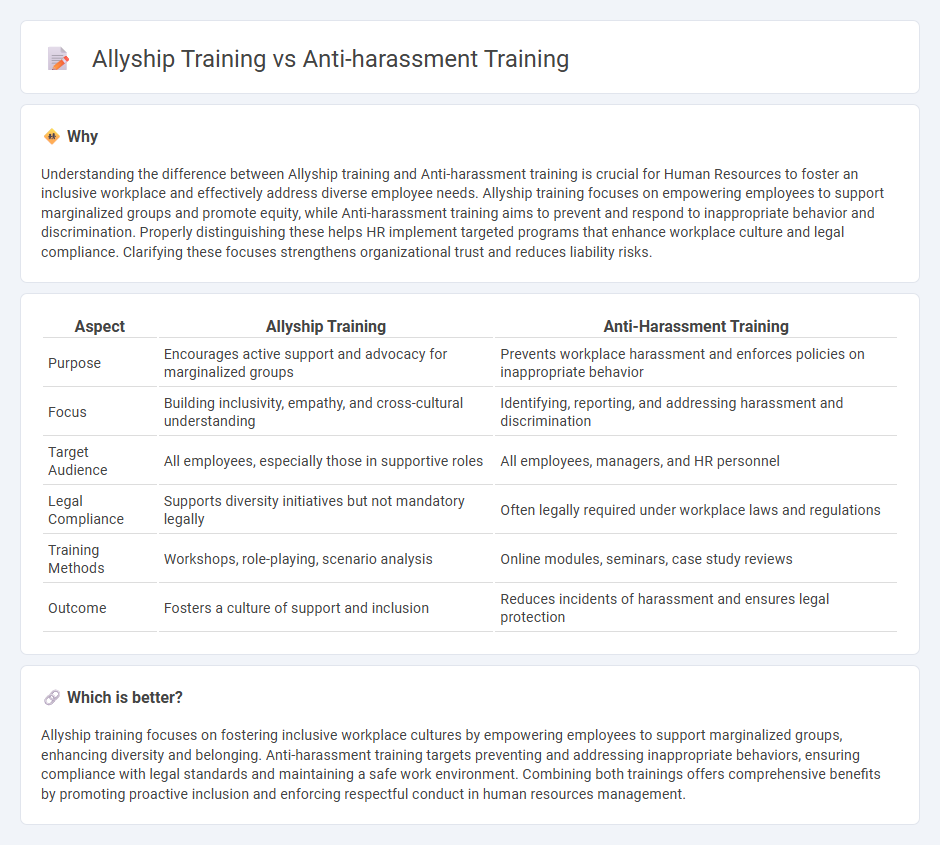
Allyship training focuses on empowering employees to actively support marginalized colleagues and foster an inclusive workplace culture, while anti-harassment training centers on preventing and addressing inappropriate behavior to ensure a safe work environment. Both training programs contribute to enhanced employee engagement, reduced turnover, and compliance with legal standards such as EEOC guidelines. Explore how integrating allyship and anti-harassment training can transform your organization's human resources strategy.
Why it is important
Understanding the difference between Allyship training and Anti-harassment training is crucial for Human Resources to foster an inclusive workplace and effectively address diverse employee needs. Allyship training focuses on empowering employees to support marginalized groups and promote equity, while Anti-harassment training aims to prevent and respond to inappropriate behavior and discrimination. Properly distinguishing these helps HR implement targeted programs that enhance workplace culture and legal compliance. Clarifying these focuses strengthens organizational trust and reduces liability risks.
Comparison Table
| Aspect | Allyship Training | Anti-Harassment Training |
|---|---|---|
| Purpose | Encourages active support and advocacy for marginalized groups | Prevents workplace harassment and enforces policies on inappropriate behavior |
| Focus | Building inclusivity, empathy, and cross-cultural understanding | Identifying, reporting, and addressing harassment and discrimination |
| Target Audience | All employees, especially those in supportive roles | All employees, managers, and HR personnel |
| Legal Compliance | Supports diversity initiatives but not mandatory legally | Often legally required under workplace laws and regulations |
| Training Methods | Workshops, role-playing, scenario analysis | Online modules, seminars, case study reviews |
| Outcome | Fosters a culture of support and inclusion | Reduces incidents of harassment and ensures legal protection |
Which is better?
Allyship training focuses on fostering inclusive workplace cultures by empowering employees to support marginalized groups, enhancing diversity and belonging. Anti-harassment training targets preventing and addressing inappropriate behaviors, ensuring compliance with legal standards and maintaining a safe work environment. Combining both trainings offers comprehensive benefits by promoting proactive inclusion and enforcing respectful conduct in human resources management.
Connection
Allyship training and Anti-harassment training are interconnected through their shared goal of fostering inclusive workplace cultures and reducing discriminatory behaviors. Both training programs emphasize recognizing unconscious bias, promoting respectful communication, and empowering employees to intervene in situations of harassment or exclusion. Implementing these trainings together enhances organizational commitment to diversity, equity, and psychological safety.
Key Terms
**Anti-harassment training:**
Anti-harassment training educates employees on identifying, preventing, and responding to workplace harassment, ensuring compliance with legal regulations such as Title VII of the Civil Rights Act. It emphasizes creating a safe environment by addressing behaviors like discrimination, bullying, and sexual harassment. Explore how structured anti-harassment programs can transform organizational culture and mitigate legal risks.
Discrimination
Anti-harassment training targets preventing and addressing workplace discrimination through clear policies and reporting mechanisms, ensuring a safe environment for all employees. Allyship training emphasizes active support from colleagues by fostering empathy, understanding biases, and promoting inclusive behaviors that combat discrimination on a cultural level. Explore how combining both approaches can create a more equitable organizational culture.
Bystander intervention
Anti-harassment training primarily targets the identification and prevention of inappropriate behaviors in the workplace, while allyship training emphasizes active support and advocacy for marginalized groups through bystander intervention. Effective bystander intervention empowers employees to recognize harmful situations and safely intervene, fostering an inclusive and respectful organizational culture. Discover more about how integrating both training types can transform workplace dynamics and promote sustained equity.
Source and External Links
Online Workplace Harassment Training for Employees - Provides interactive scenarios and real use cases to prevent workplace harassment and discrimination covering recognition, intervention, retaliation, and leadership skills for managers in building positive workplaces.
Sexual Harassment Prevention Model Policy and Training - Mandates that every New York State employer provide interactive annual sexual harassment prevention training including definitions, examples, legal provisions, and employee rights starting from October 2018.
Workplace Harassment Training - Offers an industry-leading training course aligned with U.S. legislation to help employees and managers identify, prevent, and respond to workplace harassment, covering topics like digital harassment, discrimination, and power differentials.
 dowidth.com
dowidth.com